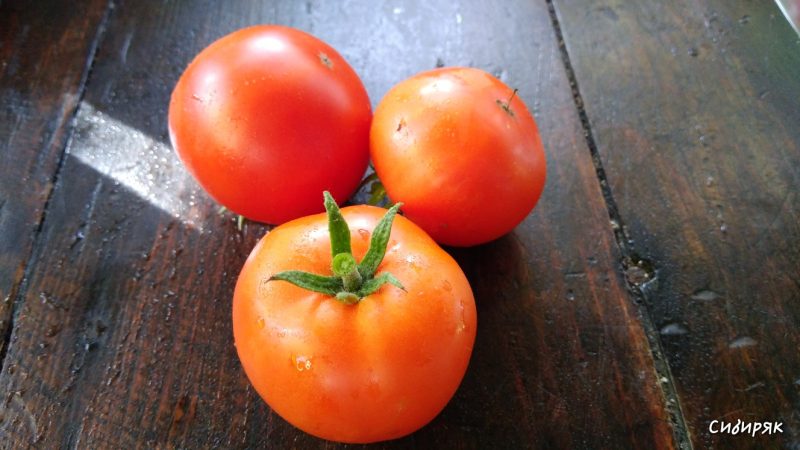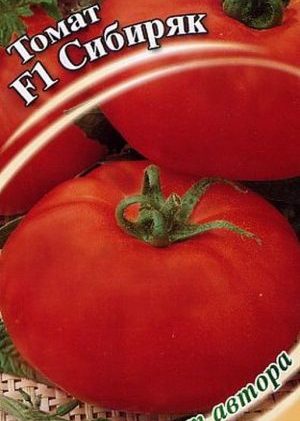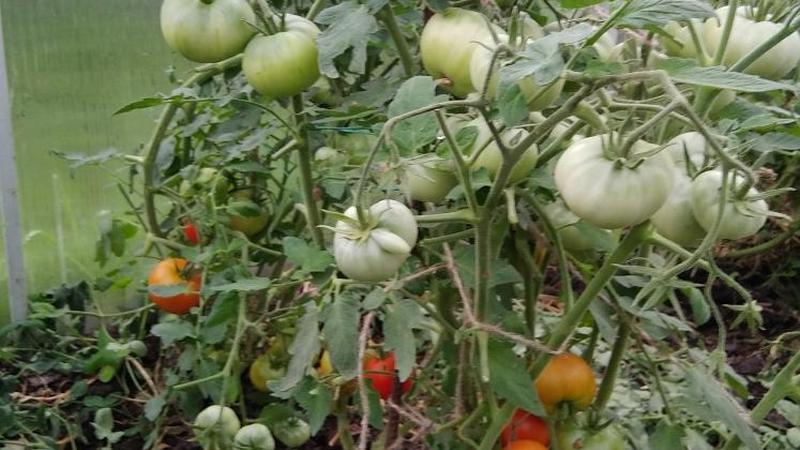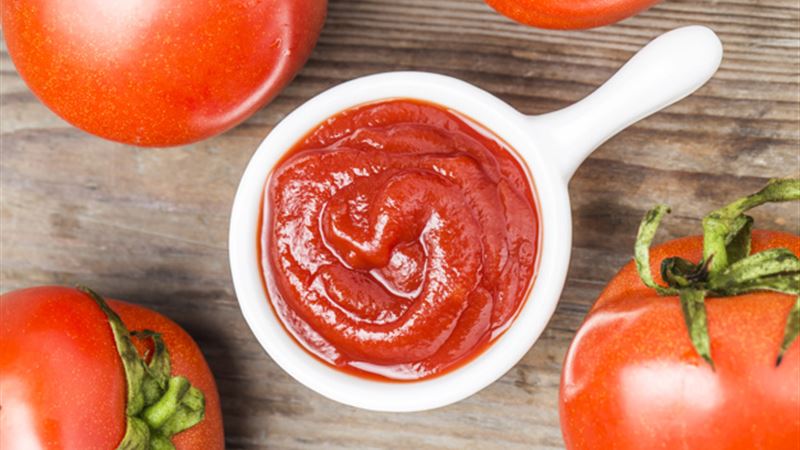Persistent and not capricious to care for, the Sibiryak tomato is ideal for growing in regions with a harsh climate
Siberian varieties and hybrids are consistently popular among vegetable growers. One of the most common crops is Sibiryak, a hybrid that has strong immunity to disease and yields a high yield of large dessert-flavored fruits.
Consider how to grow tomatoes on your own plot, what are the rules of agricultural technology, the features of harvesting and using the crop.
The content of the article
Description
The Sibiryak tomato bush has the following features:
- dark green leaves;
- the height of the main stem is 160–180 cm;
- vegetables appear every 3-4 leaves;
- 8-9 brushes are formed on the plant;
- 5-6 fruits are tied on bunches.
F1 hybrid
The hybrid is characterized by increased resistance to adverse conditions, which cannot be compared with ordinary high-quality tomatoes. Sibiryak F1 grows rapidly, has strong immunity to diseases, pests and gives an excellent harvest.
Distinctive features
Culture refers to indeterminate type of plants. Differs in stable and strong bushes. The hybrid is not afraid of cold snaps and overheating. In the northern latitudes, tomatoes are grown in greenhouses; in the south of the country, Sibiryak successfully bears fruit in the open field.

Fruit characteristics, yield
Fruiting begins 120–130 days after germination. Characteristics of tomatoes:
- the mass of one tomato is 300-400 g, but there are fruits and 600 g each;
- tomatoes have a slight ribbing;
- the shell is durable, shiny, does not crack;
- fleshy pulp;
- the number of seeds in tomatoes is small;
- the taste of tomatoes is sweet and sour.
Subject to agrotechnical rules from 1 sq. m. vegetable growers collect up to 10 kg of crops.
How to grow seedlings
Sowing seeds for seedlings is carried out in the second half of March, two months before the expected planting of plants in a permanent place. The soil for this is purchased at a gardening store or prepared independently.
Important! In containers for seedlings, a drainage layer must be made. For this, small pebbles or expanded clay are used.
Seed preparation

The seeds are disinfected. To do this, they are placed in a 1% solution of potassium permanganate for 20-30 minutes, then washed in running water and sprayed with a growth stimulator, for example, "Heteroauxin", "Epin" or "Kornevin".
For quick pecking, two days before sowing, the grains are spread on a damp cotton cloth and covered with it. Place the saucer with seeds in a cool, dark place. The cloth with the seed is periodically moistened, but the seeds are not allowed to float in the water.
Capacity and soil
Seedlings are grown in wooden boxes or in special containers with cells. Some vegetable growers use containers from available tools, for example, cut boxes of juice or milk. Still, most gardeners use peat tablets or cups.
To grow healthy seedlings, use high-quality soil:
- most gardeners for seedlings acquire a ready-made soil mixture;
- some prepare the substrate on their own by mixing garden soil, humus, sand (sawdust) and wood ash in a 2: 1: 1: 1 ratio.
Before use, the soil is disinfected - well watered with boiling water or 1% solution of potassium permanganate. This procedure will destroy all possible bacteria and larvae that cause diseases in tomatoes.
Sowing
Seeds are planted at a distance of 2-3 cm from each other. Embedding depth - no more than 0.8–1 cm. Several holes are made at the bottom of the containers to drain excess liquid. The container with seeds is covered with foil or transparent glass and removed for several days in a warm room (+25 ° C).
Growing and care
After sprouting, the seedlings are placed in a bright place, for example, on a windowsill or veranda. If the weather is cloudy and the plants do not have enough light, turn on artificial lighting. To do this, phytolamps are evenly installed over the bushes.
During this period, the plants are watered with settled water at room temperature. Waterlogging or drying out of the soil is not allowed.
When the seedlings have 2-3 true leaves, young bushes are transplanted into separate containers. For this, use spacious boxes.
In 7-10 days after the picking, the plants are fertilized for the first time with special preparations, for example, "Biohumus" or "Baikal EM1". Solutions are prepared strictly according to the instructions on the package.
Seedlings are hardened 14 days before planting plants on a permanent place of growth. For this, tomatoes are taken out into the street or balcony for a couple of hours. The time spent in the fresh air is increased every day.
How to grow tomatoes
Planting of plants in a permanent place is carried out in stable warm weather. In case of recurrent cold weather, vegetable growers have shelters made of film or spunbond, which cover the tomatoes. The culture has a strong immunity to most diseases, but experienced gardeners, just in case, process the soil with a weak solution of potassium permanganate.
Landing
The plot for tomatoes has been prepared since autumn. The bushes are planted at a distance of 40–45 cm from each other, and 60 cm are left between the rows. A small layer of ash and compost is placed on the bottom of the holes, then watered. After planting, the plants are moistened again and the supports are installed.

Care
Tomatoes are watered once a week, in hot weather - twice. The culture is moistened in the morning or evening, under the root, so that the spray does not fall on the leaves and stem. To do this, use settled or rainwater at room temperature.
After watering around the tomatoes, the soil is loosened and at the same time weeds are removed, which takes nutrients from the plants. Also, the soil is mulched with hay or grass. This will keep moisture in the ground longer and prevent weed growth.
Two weeks after planting the plants, fertilizer is applied to the soil. To do this, use an infusion of mullein or fermented herbs. The next feeding is carried out after the formation of ovaries, mineral potash and phosphorus fertilizers are added.
Important! All top dressing is applied to moist soil after watering.
If the culture grows in a greenhouse, then the structures are regularly ventilated by opening two opposite windows or doors. This is done to reduce the humidity in the air so that the plants do not get rotten.
Bushes form into one stem. As the tomatoes grow, they are tied to a support. The stepsons and yellow foliage are removed.

Features of cultivation and possible difficulties
The culture has good resistance to cold conditions, so tomatoes are grown even in the northern regions, but under covering material or in greenhouses.
The cultivation of the Siberian hybrid is no different from the cultivation of other tomatoes. To obtain a plentiful and high-quality harvest, vegetable growers follow the rules of agricultural technology.
Diseases and pests
The hybrid has a strong immunity to the following diseases of the nightshade:
- cladosporiosis;
- tobacco mosaic;
- fusarium.
Despite this, vegetable growers are taking preventive measures:
- disinfect seed material;
- decontaminate the greenhouse, inventory and soil;
- follow the rules of crop rotation;
- treat plants for preventive purposes with "Fitosporin";
- ventilate the greenhouse structure.
The most common pests on plants are Colorado beetles, slugs and spider mites. Insects are harvested by hand or processed with folk remedies. To do this, use a decoction of wormwood, infusion of garlic, onions or hot pepper.
The nuances of growing in open ground and in a greenhouse
Siberian bears fruit on almost any soil, but for this, vegetable growers follow the rules of crop rotation.
Good precursors for tomatoes:
Tomatoes are not grown after potatoes, tomatoes and other nightshades earlier than 3-4 years. Otherwise, the soil becomes a potential carrier of infections and pest larvae.
On a note. Due to its hardiness and cold hardiness, this hybrid gives a bountiful harvest outdoors, but in a greenhouse, the yield is much higher.
Harvesting and application of the crop
Tomatoes are harvested 4 months after planting, usually in early August. Harvested before the first days of October.
Tomatoes are used to prepare summer salads, first and second courses, as an addition to meat portions. Also, these vegetables make excellent ketchups, pastes, juices and sauces.

Advantages and disadvantages
One of the main advantages of the Sibiryak tomato is the ability to harvest when other tomatoes have completed their fruiting. The hybrid, resistant to cool climatic conditions, bears fruit in the greenhouse even at a later date.
Positive qualities of tomato:
- excellent taste and aroma;
- versatility of vegetables in application;
- high productivity;
- large-fruited;
- transportability;
- long-term storage of fruits;
- resistance of the hybrid to disease.
Some vegetable growers attribute the garter and pinching of bushes to disadvantages, but these techniques are used when growing all tall tomatoes. The main disadvantage of the hybrid is the inability to collect seeds from its own harvest.
Not to be confused with namesakes
Siberian tomatoes deserve special attention because of the exceptional qualities and reliability of seed material. Among the wide variety, there are tomatoes with different growing periods, from dwarf to tall vines, with fruits of a bizarre shape, color and size.
The main advantage of zoned tomatoes is the ability to give a guaranteed yield in difficult climatic conditions.
Mamin Sibiryak
The tomato was bred by Siberian breeders. Mother's Siberian is distinguished by its elongated fruit shape and high yield.
Description:
- mid-season crop, 110-115 days pass from sowing to harvest;
- the tomato belongs to the determinant plants, the bush grows up to 120-150 cm;
- the first inflorescence appears above 7-8 leaves;
- the vegetables are cylindrical, red in color and slightly thickened at the bottom of the fruit.
- tomatoes have high taste and are excellent for preserving, stuffing, preparing winter and summer salads;
- on one hand there are 5–7 fruits weighing 60–150 g;
- from 1 sq. m vegetable growers collect up to 20 kg of crops.
The tomato has excellent commercial and consumer characteristics. It is cultivated both indoors and outdoors.
Sibiryachok
An early ripe and fruitful tomato is extremely easy to care for. The fruits have excellent consumer qualities. Sibiryachok grows well indoors and outdoors.
Feature and Description:
- early ripening tomato, from sowing to harvesting the first harvest 105-110 days pass;
- the culture belongs to the determinant type of plants, growth stops after the formation of 4-5 brushes;
- the bush is compact, low, does not need a garter and pinning;
- the first brush appears above 5–7 leaves;
- fruits are round, smooth, with a strong shell of bright red color, weight 90-100 g;
- the pulp is firm, but juicy, the taste is excellent;
- vegetables are stored for a long time, suitable for winter preparations, preparing salads, mashed potatoes, juices.
Short terms of growing tomatoes are very relevant in a short summer. But some agronomic techniques allow you to get the harvest even faster. The positive characteristic and description of the variety makes the tomato very popular among consumers.
Farmers reviews
Gardeners speak about the Sibiryak F1 tomato mostly positively. Vegetable growers prefer this particular hybrid for a long list of positive qualities.
Olga, Ufa: “I always try to grow new tomatoes for myself. I decided to plant a hybrid Sibiryak. Seedlings appeared quickly, planted tomatoes in a greenhouse. The plant is productive. Vegetables of excellent taste and pleasant aroma. I prepared so much conservation that I then shared it with relatives. I really liked the hybrid and will continue to plant it. "
Svetlana, Bryansk: “I have been cultivating tomatoes for seven years in a row. I always buy tomatoes that do not require special attention. According to the description, I chose a hybrid Sibiryak. I liked that the plant produces large fruits. The vegetables have an excellent presentation, as in the photo of the package with seeds, and most importantly, they are stored for a long time. "
Conclusion
The Siberian hybrid is a real find for novice summer residents. This plant has a strong immunity to diseases, which makes growing tomatoes much easier. The crop yields bountiful crops even when grown in cool climates. Vegetables have a classic look and are stored for a long time.
For more information on growing tall tomatoes, see the following video: